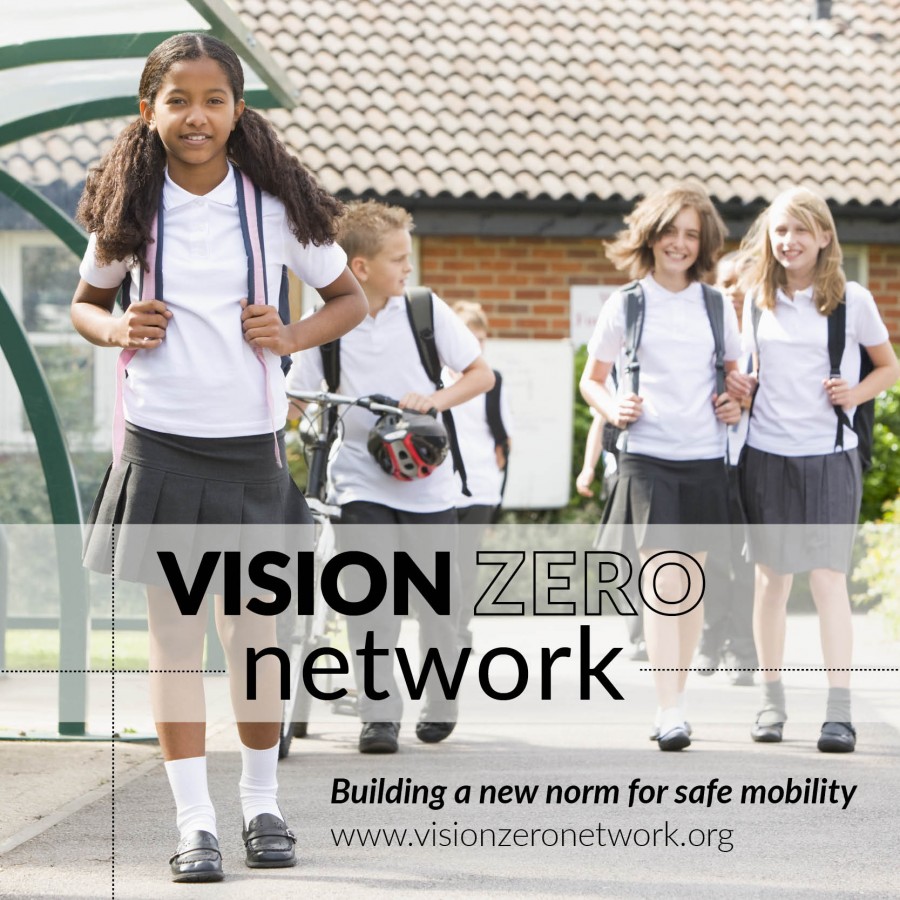In response to growing urgency to reverse the troubling trends on our streets and sidewalks — someone is killed while walking in America every 2 hours and injured every 8 minutes in traffic crashes, while an alarming number of deaths and illnesses stem from sedentary lifestyles — the Vision Zero Network officially launched today to help communities meet their goals of Vision Zero, or zero traffic fatalities and severe injuries.
Recognizing that the safety of streets and sidewalks go hand in hand with encouraging physical activity, Kaiser Permanente announced support for the Vision Zero Network, the newly formed national collaborative aimed at ensuring all people have safe and healthy ways to move around their communities. Vision Zero is a strategy emerging across the United States to eliminate traffic fatalities and injuries – particularly focusing on those walking and bicycling, who have been traditionally overlooked.
“For too long, in too many communities, our transportation systems have been out of sync with our priorities for improved health, sustainability, equity and economic well-being,” said Leah Shahum, Director of the Vision Zero Network. “Local leaders recognize that we can and must do more to ensure our citizens’ right to safe mobility. We are uniting around Vision Zero to reorient our priorities and policies to ensure that safety really is first on our streets and sidewalks.”
First launched in Sweden in 1997 and proving effective across Europe, Vision Zero is a strategy that is now building momentum in major U.S. cities, including San Francisco, Washington D.C., Portland, Seattle, and New York City, with additional cities considering action.
The Vision Zero Network, focusing initially on leading-edge U.S. cities demonstrating commitment and potential, will bring together local leaders in health, traffic engineering, police enforcement, policy and advocacy to develop and share winning strategies to make Vision Zero a reality on the ground – strategies ranging from managing speed, redesigning streets, and leading behavior change campaigns and data-driven traffic enforcement.
The Vision Zero Network received a three-year grant from the Kaiser Permanente National Community Benefit Fund at the East Bay Community Foundation. Four years ago, Kaiser Permanente catalyzed – and continues to lead – a national conversation about the benefits of walking, physical activity and active transportation.
“Kaiser Permanente wants more people to engage in physical activity, such as walking and biking, and to build that activity into their daily routine. This directly contributes to their health and well-being,” said Tyler Norris, Vice President, Total Health Partnerships, Kaiser Permanente. “But assuring access to safe streets and environments is critical to support them to be more active in the communities where they live, work and go to school.”
“The success of the Vision Zero Network will be from the collaboration of a variety of stakeholders and partnerships working together to improve the health and well-being of communities,” said Norris.
Inspired by notable improvements in traffic safety in European countries implementing Vision Zero strategies, San Francisco and New York City have been early adopters among major U.S. cities. Last year, San Francisco committed to a goal of zero traffic fatalities by 2024 and has since published an Action Strategy, made policy changes and increased funding for safe streets initiatives.
“San Francisco is proud to lead among U.S. cities committed to Vision Zero, and together we can reach this important goal of eliminating all traffic fatalities in San Francisco by 2024,” said San Francisco Mayor Ed Lee, of San Francisco. “Together with the Vision Zero Action Strategy that we developed together to guide our work over the next two years, we will learn from collaborating with other leading Vision Zero cities to ensure that our City’s streets are safe for all those who move around San Francisco.”
New York City’s high-profile commitment has helped bring Vision Zero into the mainstream in America, as Mayor Bill de Blasio has committed significant resources toward prioritizing and improving street safety in the nation’s largest city, while community members and local leaders have rallied around the Vision Zero goal.
“Too many families like ours have been impacted by traffic violence that could have been prevented,” said Amy Cohen, founding member of Families for Safe Streets, victims of traffic violence and families whose loved ones have been killed or severely injured on New York City’s streets. “We are turning our grief into action and working towards a city where people can move about safely and co-exist while walking, bicycling and driving. We encourage more cities to come together to declare that no loss of life in traffic is acceptable and acting for real change by implementing Vision Zero.”
Research shows that minorities, children, elderly and individuals in low-income urban areas are disproportionately impacted from unsafe streets, suffering a high number of pedestrian deaths.
“Forty years ago, nearly half of children walked and bicycled to school. Today, less than 15 percent of children do so — primarily because parents are concerned about traffic speed and volume and the lack of safe sidewalks, crosswalks and bike lanes in their neighborhoods,” says Cass Isidro of the Safe Routes to School National Partnership. “The challenge is particularly acute for low-income children, who have higher rates of walking to school even in the face of poorly maintained or non-existent sidewalk networks and disproportionate instances of crime. We applaud a greater focus on Vision Zero around the country to ensure that all children can have safe and healthy options where they live, go to school and play.”
To learn more about the Vision Zero Network, a fiscally sponsored project of Community Initiatives, visit visionzeronetwork.org. Updates will be shared about the growing efforts toward and learnings about Vision Zero. And follow us on Twitter: @visionzeronet
To view Kaiser Permanente’s announcement of its support of the Vision Zero Network, see kp.org/share
Source: Vision Zero Network
April 13, 2015
By Leah Shahum
http://visionzeronetwork.org/vision-zero-network-launches-to-advance-safe-streets/











